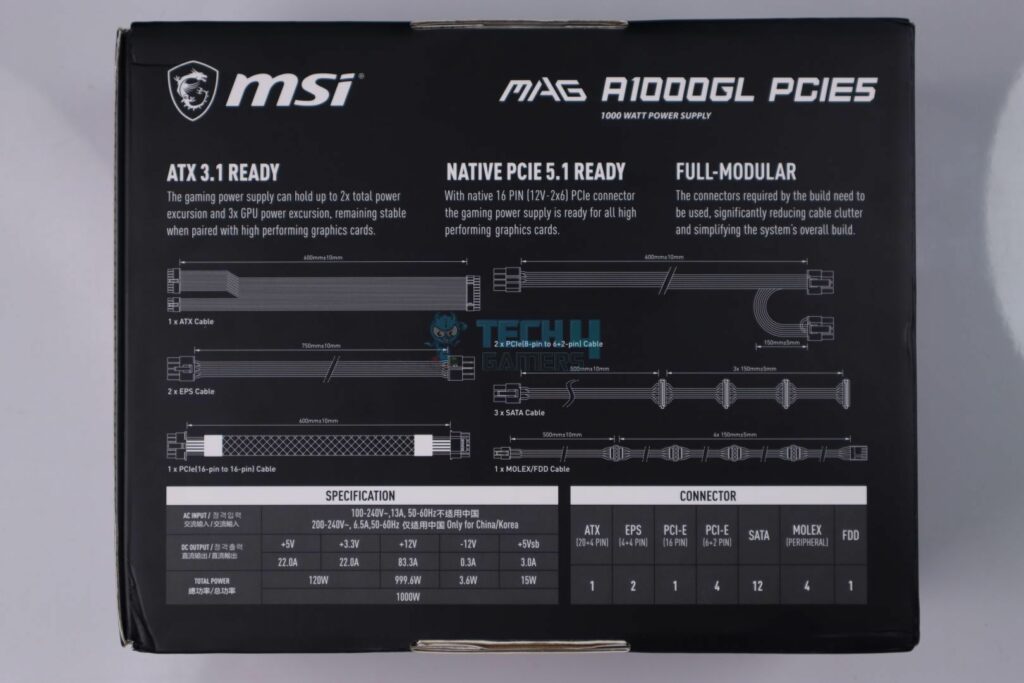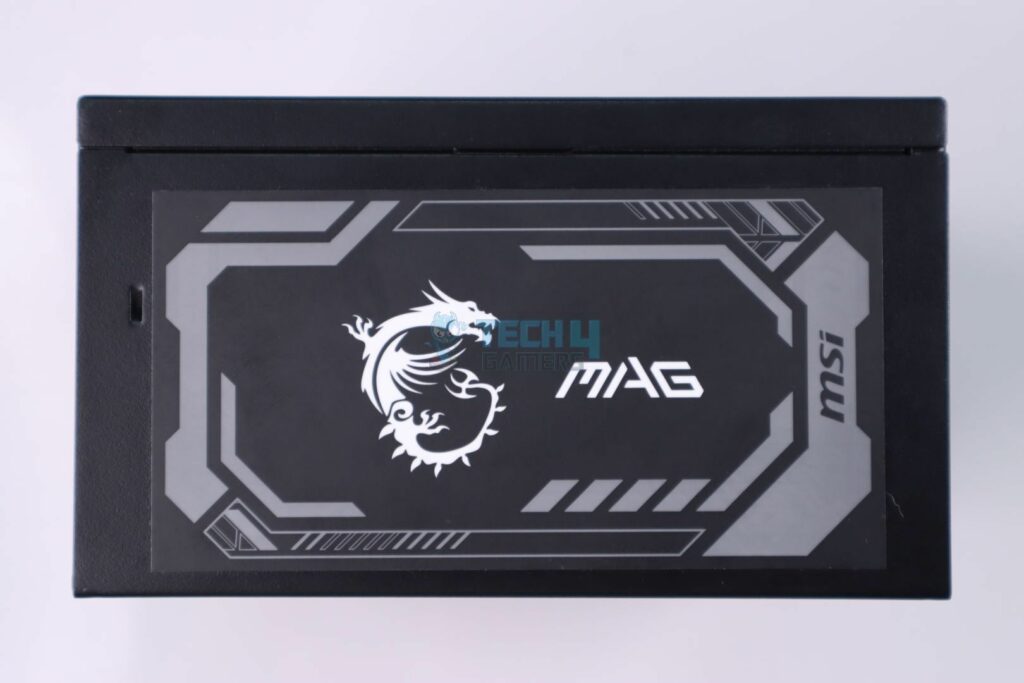Top-Notch Value!
Review Summary
The MSI MAG A1000GL PCIE5 is an excellent mid-range PSU that balances cost with modern features like the 12VHPWR connector and ATX 3.1 compliance, offering impressive efficiency and reliable power regulation. Despite a few component compromises, it performs exceptionally well for its price, making it a great choice for gamers or creators looking to power power-hungry GPUs.
Hours Tested: 8
Overall
-
Performance - 9/10
9/10
-
Build Quality - 9/10
9/10
-
Efficiency - 9.2/10
9.2/10
-
Value - 9/10
9/10
Pros
- High performance at less cost.
- Well-suited for future upgrades.
Cons
- Noisy
- May be excessive for mid-range builds
Back in the day, the PC power supply market used to struggle a lot in terms of innovation, and more specifically, it lacked excessive features that would benefit manufacturers to market their PSUs with some unique aspects and attributes.
It was only when Intel introduced new ATX3.0/3.1 specifications with massive power excursions and a new 12VHPWR connector for power-hungry GPUs the PSU market saw a paradigm shift that made every major brand immediately jump on the hype train and started adding up the new and improved PSU designs into their product catalogs.
MSI was among the first reputable brands that quickly adapted to these new PSU standards by launching the first ATX 3.0 spec PSU, MSI MPG A850G, which I also reviewed earlier.
Several other brands since then have designed and manufactured their high-end PSUs with the help of well-known OEMs; the only remaining challenge was designing such PSUs in mid-range budget options.
MSI, with its MAG A1000GL PCIE5 PSU, is now trying to fill this mid-range budget-oriented gap, and in this review, we will see how well they have succeeded in doing that.
Key Takeaways
- The MSI MAG A1000GL PCIE5 is a 1000W fully modular power supply featuring 80 PLUS Gold efficiency, ATX 3.1 compliance, and the latest PCIe 5.1 12V-2×6 connector for modern GPUs.
- You should buy the MSI MAG A1000GL if you want a solid bang for the buck power supply that is going to last you for the next several years.
- The only reason to skip the MSI MAG A1000GL is if the fan noise is a bit much for you, especially considering there is no hybrid mode, so the fan is on even at idle.
Here are the specifications:
| Specification | Detail |
|---|---|
| 80 PLUS Efficiency | Gold |
| Modular | Fully |
| Total Power | 1000W |
| Input Voltage | 100-240V |
| Input Frequency | 50-60Hz |
| Fan Size | 135mm |
| Protection | OPP, OVP, OPP, OTP, SCP, UVP |
| Dimension (D x W x H) | 150 × 150 × 86 mm |
Packaging & Unboxing
The PSU comes in a cardboard box with logos and features printed all over it. There is a picture of the power supply’s design at the front, along with a mention of its dual-color 12V-2×6 connector (which helps with installation) and some other features. The “ATX 3.1 Ready” and “PCIe 5.1 Ready” text looks like an afterthought and doesn’t really fit the overall design.
You’ll find information about the cables and the power requirements at the back.

The side design contains pretty much the same details as the front. The ATX 3.1 and PCIe 5.1 branding is much better here.
The power supply comes in black foam for protection, and MSI has used recyclable plastic inside, so there is a plus point.
Design
The front of the power supply is very basic. The fan blades are the same color as the grill. However, for the price, this is practically nitpicking, as long as the fan does the job well (will see in my tests).
At the side, there is a sticker pasted with a robotic design. While it looks good, it is misaligned. Come on, MSI, go easy on people like me with OCD.

Of course, the power supply has a fully modular design, which makes it significantly easier to manage the cables.
Cable & Connectors
The cables come in a fabric pouch, which feels good to the touch. All the cables have an adequate length, so there will be no installation issues in an ATX build.
| Connector | Quantity |
|---|---|
| Motherboard 24 (20+4) Pin | 1x |
| CPU 4+4 Pin | 2x |
| PCI 5.1 16 Pin | 1x |
| PCIe 6+2 Pin | 4x |
| SATA 15 Pin | 12x |
| Molex 4 Pin | 4x |
| FDD 4 Pin | 1x |
MSI MAG A1000GL comes equipped with the latest 12VHPWR connector, now referred to as the 12V-2×6 connector, which offers enhanced safety for GPU power delivery.
Also, MSI seems to be the only one with a unique design aspect for its 12VHPWR cable, in which a user can see whether he/she has correctly inserted the 12VHPWR connector into the GPU’s power connector. As long as the yellow part of the connector isn’t visible to the user, the connector is firmly and properly inserted.
Teardown & Component Analysis
Making the latest spec ATX3.0/3.1 PSUs cheaper poses a greater challenge because with great power excursions (allowing a PSU to provide 200x their rated power for 0.1ms) comes even greater responsibility (of maintaining 12V regulation without dropping too low).
Back then, manufacturers used to cut down on the number of components to save cost, but in doing so for the latest PSUs these days, significantly drop their performance which can result in a PSU not meeting its ATX3.0/3.1 specification. So the only option left is to cut down on the quality of components by using lesser known brands’ MOSFETs and especially Capacitors that have the most prominent impact on the final price of the PSU. This can also hit the performance if a platform isn’t designed properly.

MSI has opted for CWT for its MAG 1000GL PCIE5’s platform. I think at this point, after reviewing dozens of PSUs, I have gained this ability to know that a PSU’s OEM is CWT just by its smell (jk though, the weird smell coming out of every PSU box, especially from their cables, is making me really sick!).
CWT’s massive design improvements lately have made them the most adopted OEM for the latest spec PSUs.
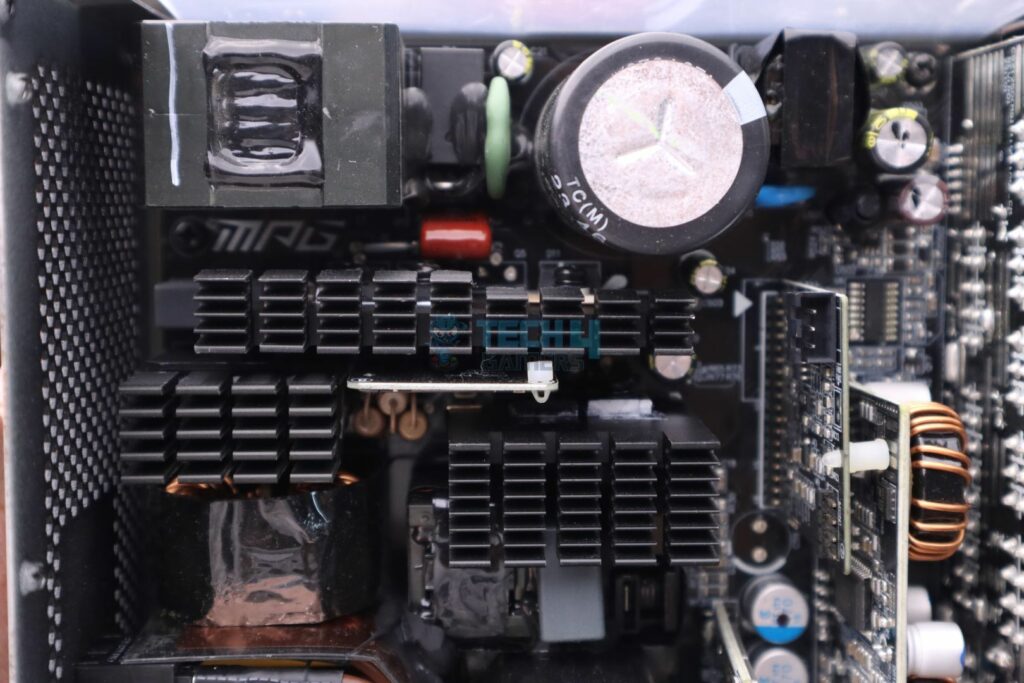
We get to see smaller but adequate heatsinks, separate for every major component: two Bridge Rectifiers, APFC Boost section, and two MOSFETs that make up Half-Bridge. The LLC converter then reduces the power losses generated by those Half-Bridge MOSFETs.
The main Transformer’s contact points are soldered directly to a vertical PCB which contains 12V rail MOSFETs, this slightly reduces power losses and makes it easier for those MOSFETs to receive adequate air flow and to cool down properly.
This is where we see how MSI has achieved a significant reduction in cost by utilizing low-tier (but not low-quality) Electrolytic and Polymer capacitors in MAG A1000GL PCIE5 PSU.
High-end PSUs inadvertently use top-of-the-line Japanese electrolytic and polymer capacitors. Here, we see a mix of Chinese (ChengX) and Taiwanese (Teapo) capacitors.
It’s good to see MSI is using Teapo branded Electrolytic bulk capacitor on the primary side, and ChengX is only being used on the secondary side. The capacity of Teapo’s capacitor is apparently quite low for a bulk capacitor, but because MAG A1000GL PCIE5 is an ATX3.1 compliant PSU, the hold-up time has now been reduced to lower levels compared to what was previously allowed in ATX3.0 specifications, an 820uF seems to be more than enough.
Also, all the electrolytic capacitors are 105C rated, which is very good. 85C-rated capacitors would have cost even less, but they have significantly less lifespan, especially when used in high ambient temperatures, so MSI isn’t cheaping out that much.
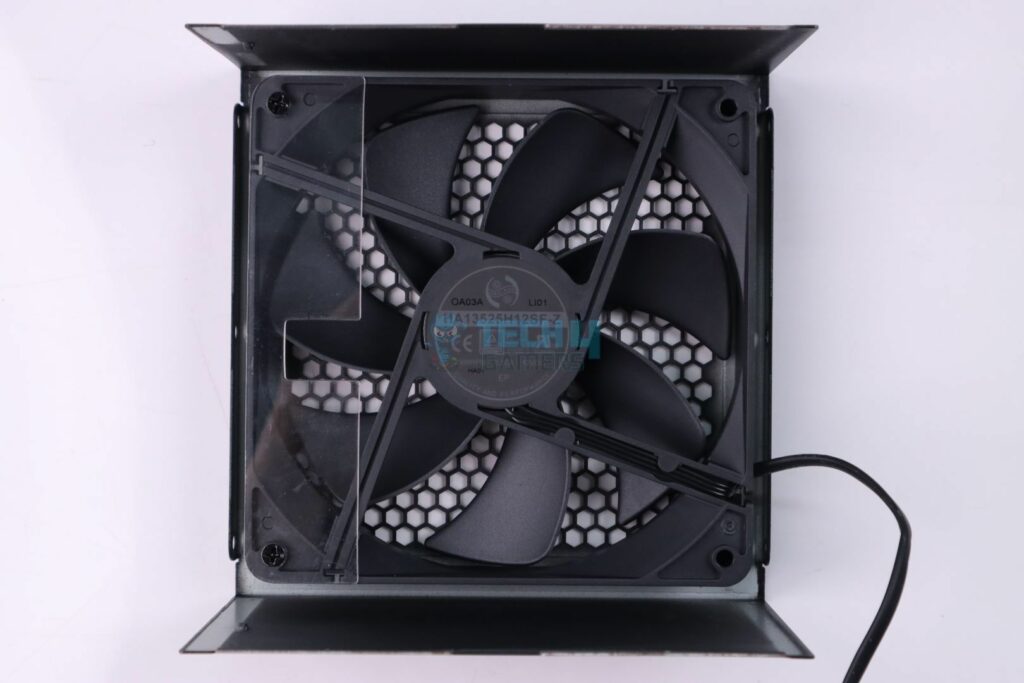
PSU Load Testing

Voltage Regulation
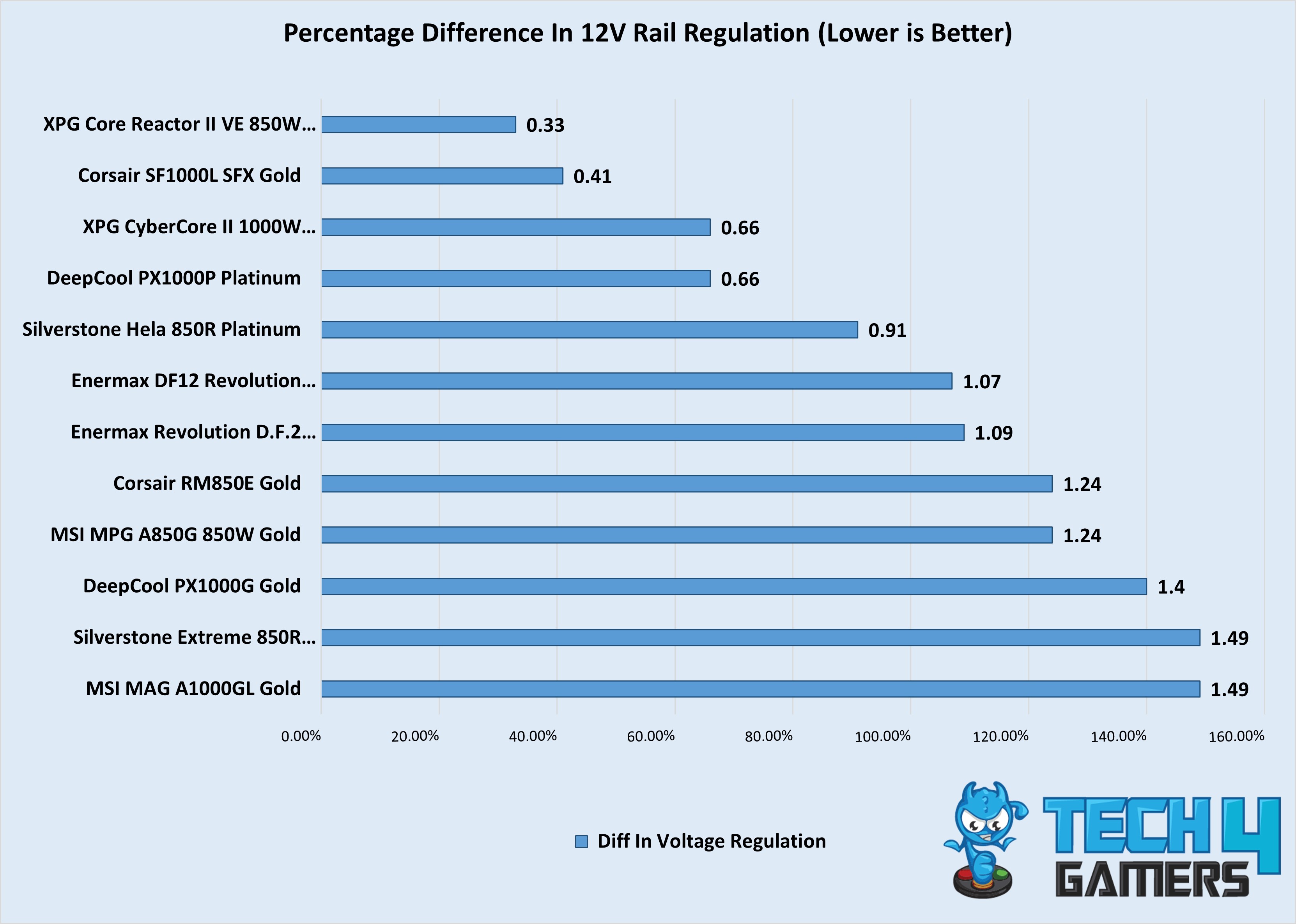
| Load in % | 12V | 5V | 3.3V |
|---|---|---|---|
| 20% | 12.10V | 5.06V | 3.36V |
| 50% | 12.00V | 5.06V | 3.35V |
| 70% | 11.95V | 5.05V | 3.35V |
| 90% | 11.93V | 5.05V | 3.35V |
| 100% | 11.92V | 5.05V | 3.35V |
I have seen budget-oriented PSUs struggling in my voltage regulation test, dropping the 12V rail much lower, but MAG A1000GL performed really well and maintained its 12V throughout the test.
PSU Efficiency

| Load in % | Efficiency | Power Factor |
|---|---|---|
| 20% | 90.62% | 0.953 |
| 50% | 93.14% | 0.983 |
| 70% | 92.91% | 0.986 |
| 90% | 92.07% | 0.988 |
| 100% | 91.65% | 0.989 |
Though we have seen slightly higher power efficiency numbers in some of the latest CWT platforms used in major brands PSUs these days, still with an average efficiency of 92.08%, MAG A1000GL has no problem maintaining an 80 Plus Gold efficiency rating.
Voltage Ripple Performance

| Load in % | 12V Ripple |
|---|---|
| 20% | 7.2mV |
| 50% | 14.4mV |
| 70% | 13.6mV |
| 90% | 14.4mV |
| 100% | 15.2mV |
Voltage ripple performance is surprisingly good, especially for its price point. MSI’s extensive use of Polymer capacitors resulted in this impressive performance.
Temperatures
Having no Hybrid Fan mode makes the fan spin all the time, resulting in cooler operation throughout the max-rated load. Max’s hottest point was reported to be as high as 45.9C on its back. There’s a noticeable fan noise when the PSU is hit with 70% load.
Should You Buy it?
Buy It If
✅You want an affordable and reliable PSU: This mid-range budget-oriented option is not gonna hit hard on your wallet, nor is it going to make you upgrade your PSU in the future, as 1000W is more than enough for even an RTX4090.
✅You Like ease of mind: A massive 10-year warranty at this price point is really impressive.
Don’t Buy It If
❌You want silent operation: MSI MAG A1000GL’s noise levels may upset a few individuals who aren’t that much into Rock n Roll/loud music.
My Final Thoughts
MSI has been doing really well for its latest spec high-end PSUs lately; now, with their MAG A1000GL PCIE5 PSU, MSI is targeting mid-range budget PC Gamers with no compromises in performance.
The MSI MAG A1000GL PCIE5 is a great option for anyone who wants modern features without paying top dollar. It supports ATX 3.1 and PCIe 5.1, so it’s perfect for newer, more demanding GPUs. Even though it uses mid-tier capacitors, MSI included Teapo capacitors on the primary side, which helps keep performance solid. The 135mm fan does a good job of managing heat, although the lack of hybrid fan mode means you have to keep up with slightly higher noise levels
With an average efficiency of 92%, a 1.49% difference in voltage regulation (across 12V rail), and a maximum ripple of just 15.2mV, the A1000GL packs remarkably good performance. In short, if you’re building a high-end gaming or creative setup but don’t want to overspend, this PSU is definitely worth considering.
Community Poll
Coming Next: Enermax Revolution D.F.2 1200W Review
Thank you! Please share your positive feedback. 🔋
How could we improve this post? Please Help us. 😔
[Errors Troubleshooting Expert]
Arsalan Shakil (aka GuyThatDoesEverything on YouTube) is a PC Tech Enthusiast and Electronic Geek. With over 10+ years of experience in Electronics, he then decided to explore Software Engineering to design embedded products and automate existing hardware solutions.
When he started tearing down old cameras to understand how they worked, he was shocked (literally, when he got zapped by a flash discharge capacitor), giving him the power (debatable) to fall in love with videography/photography. He also started making some fun videos that later became YouTube tech reviews.
Skills:
- 10+ years of experience in Electronics design, embedded solutions, and prototyping
- Majored in Software Engineering
- Research paper publication in IEEE for Embedded Military Uniform & LoRa WAN wireless technology
- Specialized in IoT Solutions
- PC Enthusiast & PC Modder
In his local region, he’s known to expose cheap PSU brands, often claiming fake certification or false claims on the box. He’s a true nerd and needed some friends in his life. Then he met some guys who work at Tech4Gamers, and they also came out to be equal nerds who suggested he join Tech4Gamers as a Hardware Expert.


 Threads
Threads

